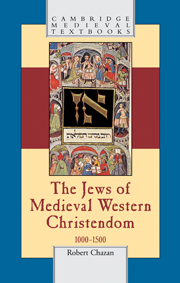Book contents
- Frontmatter
- Contents
- List of maps
- Preface
- Introduction
- 1 Prior legacies
- 2 The pan-European Roman Catholic Church
- 3 The older Jewries of the south
- 4 The newer Jewries of the north: northern France and England
- 5 The newer Jewries of the north: Germany and Eastern Europe
- 6 Material challenges, successes, and failures
- 7 Spiritual challenges, successes, and failures
- Epilogue
- Notes
- Bibliography
- Index
- Cambridge Medieval Textbooks
2 - The pan-European Roman Catholic Church
Published online by Cambridge University Press: 05 June 2012
- Frontmatter
- Contents
- List of maps
- Preface
- Introduction
- 1 Prior legacies
- 2 The pan-European Roman Catholic Church
- 3 The older Jewries of the south
- 4 The newer Jewries of the north: northern France and England
- 5 The newer Jewries of the north: Germany and Eastern Europe
- 6 Material challenges, successes, and failures
- 7 Spiritual challenges, successes, and failures
- Epilogue
- Notes
- Bibliography
- Index
- Cambridge Medieval Textbooks
Summary
Medieval western Christendom encompassed a vast area and included diverse peoples, languages, economies, political systems, and cultures. This heterogeneity makes a linear history of the Jews in medieval Latin Christendom impossible, necessitating the treatment of diverse sets of Jewries, which will be undertaken shortly. There was, to be sure, one unifying institution in medieval western Christendom, and that was the Roman Catholic Church, hierarchically organized with its center at the papal court in Rome. The Roman Catholic Church was in fact the common element that enables us to speak of western Christendom as a more or less coherent entity. It was also the institution on the medieval scene with the richest heritage as regards Judaism and the Jews, a legacy of late antiquity that demanded respect. Finally, it was the institution in medieval western Christendom with the most intense commitment to clear formulation of doctrine and behavioral norms.
All this is not meant to suggest that consistency was achieved all through western Christendom with respect to theological doctrine, ecclesiastical policy, or imagery of Judaism and the Jews. The diversity of medieval western Christendom and the varying perspectives of different groupings within majority society and even within the Church itself precluded unanimity with respect to the Jews or any other issue. In this chapter, the focus will be on broad issues of doctrine, policy, and imagery of the Jews, as reflected largely in papal pronouncements. On occasion, a relatively authoritative non-papal voice will be introduced.
- Type
- Chapter
- Information
- The Jews of Medieval Western Christendom1000–1500, pp. 43 - 76Publisher: Cambridge University PressPrint publication year: 2006



